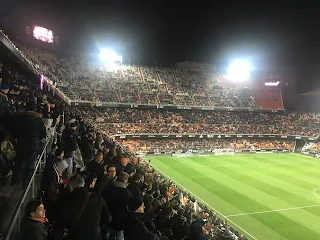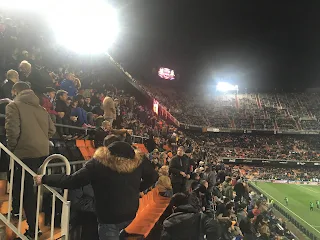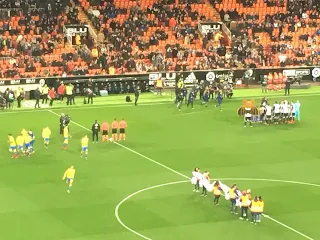Valencia Club de Fútbol, or Valencia CF, is a professional football club from the Spanish east coast city of the same name that was formed on March 18th 1919 and played their initial matches at the Algirós ground. The club moved into Estadio de Mestalla in 1923, which was inaugurated with a game on the 20th May against local rivals Levante UD.
The move to the new stadium heralded success on the pitch as ‘Los Murciélagos’ were crowned as regional champions. Valencia won Segunda División in 1930-31 to gain promotion to the top flight La Liga for the 1931-32 season, with the team generally finishing in the lower reaches.
The team ended in third place in 1940-41, as well as winning the Copa Del Rey for the first time, following a 3-1 victory against RCD Español at Estadio Chamartín in Madrid. The 1940-41 campaign saw Valencia becoming Spanish champions for the first time as Mundo finished as top scorer in a team led by coach Ramón Encinas Dios.
Eduardo Cubells was at the helm in 1943-44 as a second title followed. The third La Liga title of the decade arrived at the Mestalla in 1946-47 with Luis Casas Pasarín in charge of the team. The 1948-49 season saw the team win the Copa del Generalísimo, as the Copa Del Rey was known at the time.
A goal from Epi was enough to defeat Atlético de Bilbao in Madrid. The Mestella had been increased to accommodate a crowd of 45,000 as Spanish international Antonio Puchades and Dutch forward Faas Wilkes thrilled the supporters. In 1952-53, Valencia finished as league runners-up for the third time in a few seasons.
The 1953-54 campaign saw the team win the National Cup for a third time. A brace from Antonio Fuertes and another goal from Manuel Badenes was enough for the side of Jacinto Quincoces to defeat CF Barcelona 3-0 in front of 110,000 at Estadio Chamartín.
The rest of the 1950s saw Valencia finishing towards the top end of the La Liga final table before the club embarked on European football in the early 1960s, as success came in the Inter-Cities Fairs Cup. In 1961-62, wins against Nottingham Forest, Lausanne Sports, Internazionale, and MTK Budapest set up a final against FC Barcelona.
Valencia hammered them 6-2 at home before drawing the away leg 1-1. Domingo Balmanya was in charge of the team as Vicente Guillot scored a hat trick in the first leg. Argentinian Alejandro Scopelli took charge of the side in 1962-63 as Valencia reached the final again
Victories against Celtic, Dunfermline Athletic, Hibernian and AS Roma led to the final. In their away leg, the team defeated Dinamo Zagreb 2-1 before winning 2-0 at the Mastella to secure the trophy. Valencia reached a third Inter-Cities Fairs Cup final in 1963-64 when they lost 2-1 in a one-off game against Real Zaragoza at the Camp Nou in Barcelona.
Former goalscoring hero Mundo was in his second spell as coach when the next major honour arrived as Waldo became the latest top scorer. The Copa del Generalísimo was lifted for a fourth time in 1966-67 after Club Atlético de Bilbao were beaten 2-1 at Estadio Santiago Bernabéu as Jara and Paquito netted the goals.
A couple of coaches had turns after Mundo before the legendary Alfredo Di Stéfano took over in June 1970. The Primera División title, as La Liga was officially known at the time, was won in 1970-71 as the club became national champions for the fourth time. The following season saw Valencia finish as league runners-up and Cup finalists for a third consecutive year.
Austrian midfielder Kurt Jara joined the club in 1973 before Di Stéfano was replaced by Milovan Ćirić, Dragoljub Milošević and then Manolo Mestre. Dutch maestro Johnny Rep joined the club in 1975, followed by Argentine hero Mario Kempes a year later.
Pasieguito took over as coach, following spells from Heriberto Herrera and Marcel Domingo; with the former midfield hero taking the team to lift the Copa Del Rey in 1978-79 with a 2-0 victory against Real Madrid with a couple of Kempes goals.
Di Stéfano returned for the 1979-80 season as Valencia defeated B1903, Rangers, FC Barcelona and FC Nantes to set up a final against Arsenal at Stade du Heysel in Brussels. The game ended 0-0 with Valencia winning 5-4 on penalties, with goalkeeper Carlos Pereira the hero.
 |
| The half-finished Nou Mestalla |
Pasieguito, Mestre, Miljan Miljanić, Koldo Aguirre, Paquito and Óscar Rubén Valdez all took turns as coach as the star players moved on and the team struggled. Di Stéfano could not save the team from relegation in 1985-86 with morale at a low because of unpaid staff and players.
A new President, Arturo Tuzón, arrived and backed the coach, who led the team to promotion and the Segunda División title at the first time of asking. Bulgarian forward Luboslav Penev was signed, with Víctor Espárrago taking over team affairs before the arrival of Guus Hiddink in July 1993
The Dutchman steered the side to several top-four finishes. The Brazilian World Cup winning manager, Carlos Alberto Parreira, arrived at the Mastella in August 1994 to replace the Dutchman. Andoni Zubizarreta, Oleg Salenko and Predrag Mijatović were signed, but the results on the pitch didn’t match the investment.
This led to former Spanish national manager Luis Aragonés arriving to fill the manager’s shoes. Jorge Valdano arrived as more big signings in the shape of Romário, Claudio López, Ariel Ortega, and Adrian Ilie pulled on the team shirt. Claudio Ranieri took over as the head coach in September 1997.
The Italian led his side to lift the Copa Del Rey in 1998-99, where Atlético de Madrid were defeated 3-0 at La Cartuja in Sevilla, thanks to two goals from Claudio López and the latest midfield star, Gaizka Mendieta. A fourth-place league finish saw Valencia qualify for the UEFA Champions League in 1999-00 as Héctor Cúper replaced Ranieri.
The team progressed through the two group stages before defeating SS Lazio and FC Barcelona in the knockout rounds. Valencia met Real Madrid in the final at Stade de France, with Real winning 3-0. Despite this setback, the team would return to a second final the following season after knock-out wins against Arsenal and Leeds United.
The 2000-01 final was played at the San Siro in Milan. Mendieta put Valencia 1-0 ahead with a penalty against FC Bayern München before the Germans equalised from the spot. The tie went to a penalty shoot-out out which Bayern won 5-4. This was a vintage Valencia side containing stars such as Santiago Cañizares, Jocelyn Angloma, Roberto Ayala, Mauricio Pellegrino, Mendieta, Pablo Aimar, Didier Deschamps and John Carew.
Rafael Benítez was appointed as the new coach in July 2001, with the majority of the squad remaining in place. Benítez led Valencia to a fifth La Liga title in 2001-02. The team regained the national title in 2003-04 in dramatic circumstances.
Real Madrid were eight points clear in February, but their form dipped, culminating in losing their final five matches. Meanwhile, Valencia put a tremendous run together and overtook them to lift the crown.
The team completed a double by winning the UEFA Cup. AIK, Maccabi Haifa, Galatasaray, Gençlerbirliği, Bordeaux and Villarreal were defeated as Valencia reached the final to play against Olympique de Marseille at Gothenburg’s Ullevi. Goals from Vicente and Mista secured a 2-0 win.
Ranieri returned for a brief spell after Benítez took up the manager’s job at Liverpool, followed by Antonio López and then Quique Sánchez Flores in July 2005. A string of disappointing performances led to the appointment of Ronald Koeman as coach in November 2007.
At this point, work had begun on the construction of Nou Mestella, to replace the original a few kilometres across the city. However, the planned opening date of the 2009-10 season soon ran aground owing to financial troubles. Koeman led the side to the Copa Del Rey the following April with a 3-1 victory over Getafe CF in Madrid.
Roberto Soldado scored the goals for a couple of years before being sold to Tottenham Hotspur in the summer of 2013. The constant turnover of head coaches did nothing to assist stability on the pitch.
Miroslav Dukic, Juan Antonio Pizzi, Nuno Espírito Santo, Gary Neville and Pako Ayestarán all lasted for around six months, with Voro filling in as caretaker on numerous occasions. Italian Cesare Prandelli fared even worse before Marcelino took up the reins in July 2017.
In October 2017, it was announced that the club would be entering into negotiations with the city council in an attempt, after several false dawns, to complete Nou Mastella. On the pitch, the team finished fourth in La Liga in 2017-18, before the team won the Copa Del Rey the following season, defeating Barcelona 2-1 with goals from Kevin Gameiro and Rodrigo.
Albert Celades arrived as manager at the Mestalla in September 2019 before being replaced by Javi Gracia for the 2020-21 campaign, which again ended in disappointment. José Bordalás was put in charge of the team in May 2021, as Valencia reached the final of the Copa Del Rey, losing on penalties to Real Betis.
Gennaro Gattuso was brought in as manager in the summer of 2022 as the team finished far too close to the relegation places after Rubén Baraja replaced the Italian, before a vast improvement twelve months later. Carlos Corberán was appointed as manager in December 2024, while the club worked hard off the pitch to be able to make a big announcement.
Finances were secured so that Nou Mestalla, with a capacity of 70,000, could be completed, with 2027 the intended target.
Valencia CF will play in La Liga in the 2017-18 season.
My visit
My visit
Valencia CF 4 UD Las Palmas 0; Valencia win 5-1 on aggregate (Tuesday 9th January) Copa Del Rey Round of 16, 2nd Leg (att: 27,869)
The Copa Del Rey second legs fell perfectly as it coincided with the final week of my 2017 annual leave. Local rivals Levante UD and neighbours Villarreal CF were also at home, so I booked flights well in advance for £55 return and prayed for kind scheduling.
It was my lucky day with Valencia playing on Tuesday, with Villarreal the following evening. It could only have been better if I could have stayed an extra night to catch the Levante game.
I’d purchased my online ticket for the match with a print-at-home option for €16, including the €2 booking fee. I was really looking forward to visiting Mestalla and I wasn’t to be disappointed with either the stadium or the city.
I’d done plenty of sightseeing from my arrival, along with visits to the homes of CF Torre Levante and Paterna CF and a look at the half-completed Nou Mestalla. After a couple of libations, I checked in at my comfortable room at the Hulot B&B in the old town for a siesta.
Unsure of where to go for a free match beer, I eventually decided to walk to Colón and take the Metro a couple of stops to Aragón, the nearest station to Mestalla. I soon walked around behind the Main Stand, where I found fans congregating and using several bars.
My attention was drawn to a sign saying “Museo” above the Bar Manolo del Bombo. It turned out to be owned by Manolo, the legendary Spanish supporter who took drums to matches several decades before it became the trend.
The great man was dressed in a full supporting outfit and grafting behind the bar, assisting his extremely aesthetic staff. The place was full of memorabilia, with drums commemorating matches and tournaments along with signed shirts and photos.
Manolo carried on pouring while posing for pictures, as customers were welcome to go behind the bar. I could have spent a lot longer in there if it were quiet to have a proper look around. The beer was cheap and the atmosphere excellent. It was just what was required.
Many fans opted to carry on drinking in the bar and outside in the square, but I still had to work out how to get inside the stadium. The lettering wasn’t very clear, but I found my correct gate after one false attempt and a lap outside.
Once inside the stadium concourses and interior were very basic, in common with the Nou Camp in Barcelona. There was not a lot of room for the facilities that modern fans demand. Toilets and limited catering kiosks were small huts. There wasn’t a TV in sight.
In a way, I enjoyed the fact that those attending were there purely for the football, rather than enjoying a meal and the sideshow. Nothing looks worse at modern stadiums than empty seats in the corporate areas as “customers” have their fill.
I hadn’t seen anything yet, but I thought the gate system outside was confusing. I found the entrance to my block, but I hadn’t a clue where my actual seat was. The stewards seemed to be there for display purposes only.
Not that I was too worried. The stadium was far from full, so I waited until kick-off and selected the best empty view. I sat under the overhang of the tier above after taking a group photo for some fans. I took in what was an amazing venue. Three open sides had three huge, steep tiers of seating.
The front of the second and third tiers hung over the level below. It offered a little bit of cover, but more importantly, it meant that the stands were close to the pitch and enclosed the noise. The fourth side was a Main Stand with a roof with corporate facilities, and two tiers of seating.
The hosts had scored a valuable away goal in the first leg in the Canaries a week earlier and came into the match as strong favourites to progress. They held third place in the La Liga table, whereas Las Palmas were down in bottom place.
As expected, Valencia put the pressure on from an early stage. Las Palmas defended deeply and tried to frustrate their opponents and supporters, with little attacking threat. Gonçalo Guedes, Simone Zaza and Luciano Vietto all went close on occasions.
Eventually, ‘Los Che’ found a way through after half an hour. Nacho Gil crossed for Zaza to see his diving header saved by keeper Raúl Lizoáin, before Argentinian striker Vietto pounced to net his first goal in over a year.
Before the break, the visitors saw an equaliser chalked off by referee Carlos Del Cerro, after he adjudged that Jairo y Calleri pushed his marker before heading home past a static Jaume Doménech in the home net.
At the interval, I decided to have a walkabout to get some new angles for photos. I noticed that access was available into a corner block, which had no fencing, denying a further move behind the goal. I don’t suppose I cut a graceful figure as I walked down a tight row full of fans!
I’d taken up a place under the overhang in time to see Valencia double their lead. Fine work out wide from Manchester United loanee Andreas Pereira set up Vietto in the box, from where the clever forward dinked the ball over Lizoáin and into the far corner.
Pressure from Pereira and Martin Montoya led to a weak clearance falling to Nemanja Maksimović, who fired in an absolute beauty on fifty-four minutes to make it 3-0 and end any lingering hopes of Las Palmas.
The best was still to come ten minutes later. Vietto spotted Lizoáin off his line and fired in a tremendous effort from close to fifty yards to the delight of the locals. The star of the show left to a standing ovation five minutes later.
The final twenty minutes petered out. Valencia boss Marcelino García Toral used all three substitutes with his side in total control as they progressed to the quarter finals of the Copa Del Rey.
I departed with just a few seconds remaining to get down the many steps and out of the way. Rather than queueing for the Metro, I decided to walk back to my room to get my spare pair of reading glasses, as my plastic-framed originals had snapped!
My plan was to head to the area around Carrer dels Cavallers, as I had read that it would offer me the best options for bars and a late drink. It wasn’t as busy as expected, although it was a Tuesday night in January.
I came across Café Negrito on Plaça del Negret as I’d decided to head towards Finnegans Irish Pub. My phone App said Negrito opened until 3.30am, so that made my decision easy; not that I intended to stay out as late as that.
The beer was decent and a fair price, and the music eclectic but mainly American-based with a mixture of funk, soul, soft rap and pop. I settled down to enjoy three pints before heading back down a maze of narrow streets. Somehow, I found the Hulot BB. It had been a long and fantastic day in a wonderful city.
Wednesday 10th January 2018
The weather was chilly but bright and sunny the following morning, so I decided to blow away the cobwebs with a fifteen-minute walk back to Mastella to take some better photos in daylight before heading to Colón for a spot of breakfast.































No comments:
Post a Comment